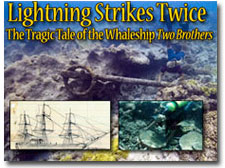|
Two Brothers  Whaling ship captain George Pollard, was either the luckiest or unluckiest captain in the U.S. whaling fleet depending on one's perspective. He endured a brutal ordeal of having his first ship Essex sunk by a whale (the inspiration for Moby Dick) and survived in a lifeboat at sea by cannabalising dead crewmen. Just three years later, he once again lost a ship under his command, the Two Brothers, when he ran aground on French Frigate Shoals in the mid-Pacific and which is today's Papahanoumokuakea Marine National Monument. Read here about Pollard's second rescue and the exciting rediscovery of Two Brothers and what it means to our understanding of the importance of the Pacific whaling industry to the United States economic growth as an emerging 19th century maritime power. Whaling ship captain George Pollard, was either the luckiest or unluckiest captain in the U.S. whaling fleet depending on one's perspective. He endured a brutal ordeal of having his first ship Essex sunk by a whale (the inspiration for Moby Dick) and survived in a lifeboat at sea by cannabalising dead crewmen. Just three years later, he once again lost a ship under his command, the Two Brothers, when he ran aground on French Frigate Shoals in the mid-Pacific and which is today's Papahanoumokuakea Marine National Monument. Read here about Pollard's second rescue and the exciting rediscovery of Two Brothers and what it means to our understanding of the importance of the Pacific whaling industry to the United States economic growth as an emerging 19th century maritime power.
Battle of the Atlantic  2010 saw archaeologists from NOAA's Monitor National Marine Sanctuary and Maritime Heritage Program complete their third phase of a multi-year expedition to document the historic shipwrecks from World War II's Battle of the Atlantic in the waters off of North Carolina. Read here how NOAA and its partners are recording some of the last vestiges of WWII that were brought up to the U.S. mainland in one of the nation's darkest hours. 2010 saw archaeologists from NOAA's Monitor National Marine Sanctuary and Maritime Heritage Program complete their third phase of a multi-year expedition to document the historic shipwrecks from World War II's Battle of the Atlantic in the waters off of North Carolina. Read here how NOAA and its partners are recording some of the last vestiges of WWII that were brought up to the U.S. mainland in one of the nation's darkest hours.
In Search of the Lost Whaling Fleets  During the latter half of the 19th and into the 20th centuries, whaling fleets from a variety of nations concentrated their efforts far to the North, among the bergs and ice pack of Alaska's north slope. This was one of the last refuges of the oil-rich Bowhead whale. The harsh extremes found in the Arctic made the hunt particularly hazardous, and on two occasions, 1871 and 1876, whole fleets were trapped by the ice and crushed. Read their story here. During the latter half of the 19th and into the 20th centuries, whaling fleets from a variety of nations concentrated their efforts far to the North, among the bergs and ice pack of Alaska's north slope. This was one of the last refuges of the oil-rich Bowhead whale. The harsh extremes found in the Arctic made the hunt particularly hazardous, and on two occasions, 1871 and 1876, whole fleets were trapped by the ice and crushed. Read their story here.
 Fathoming Our Past, the Historical Contexts of the National Marine Sanctuaries ( 9.7MB) Fathoming Our Past, the Historical Contexts of the National Marine Sanctuaries ( 9.7MB) |



